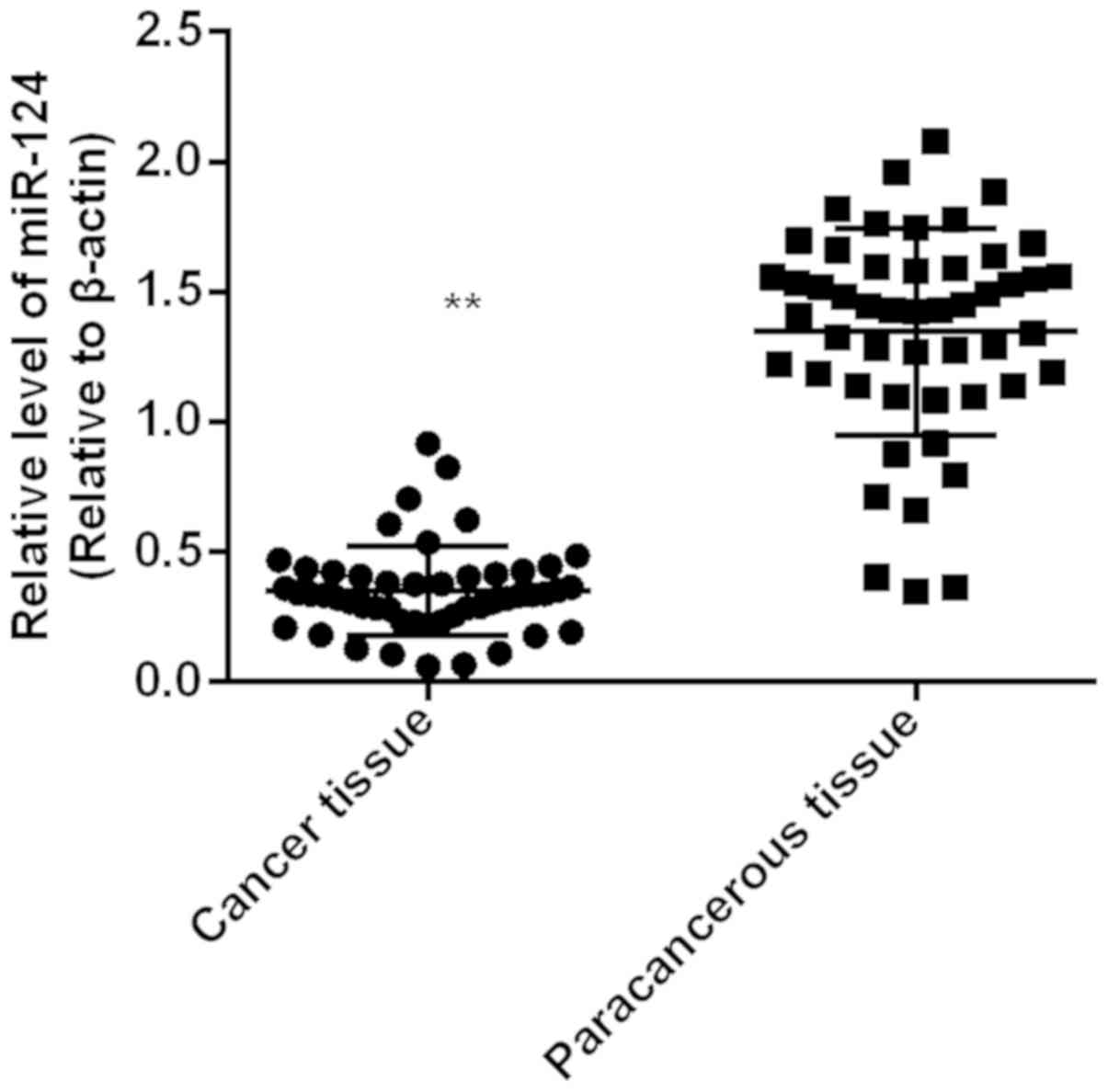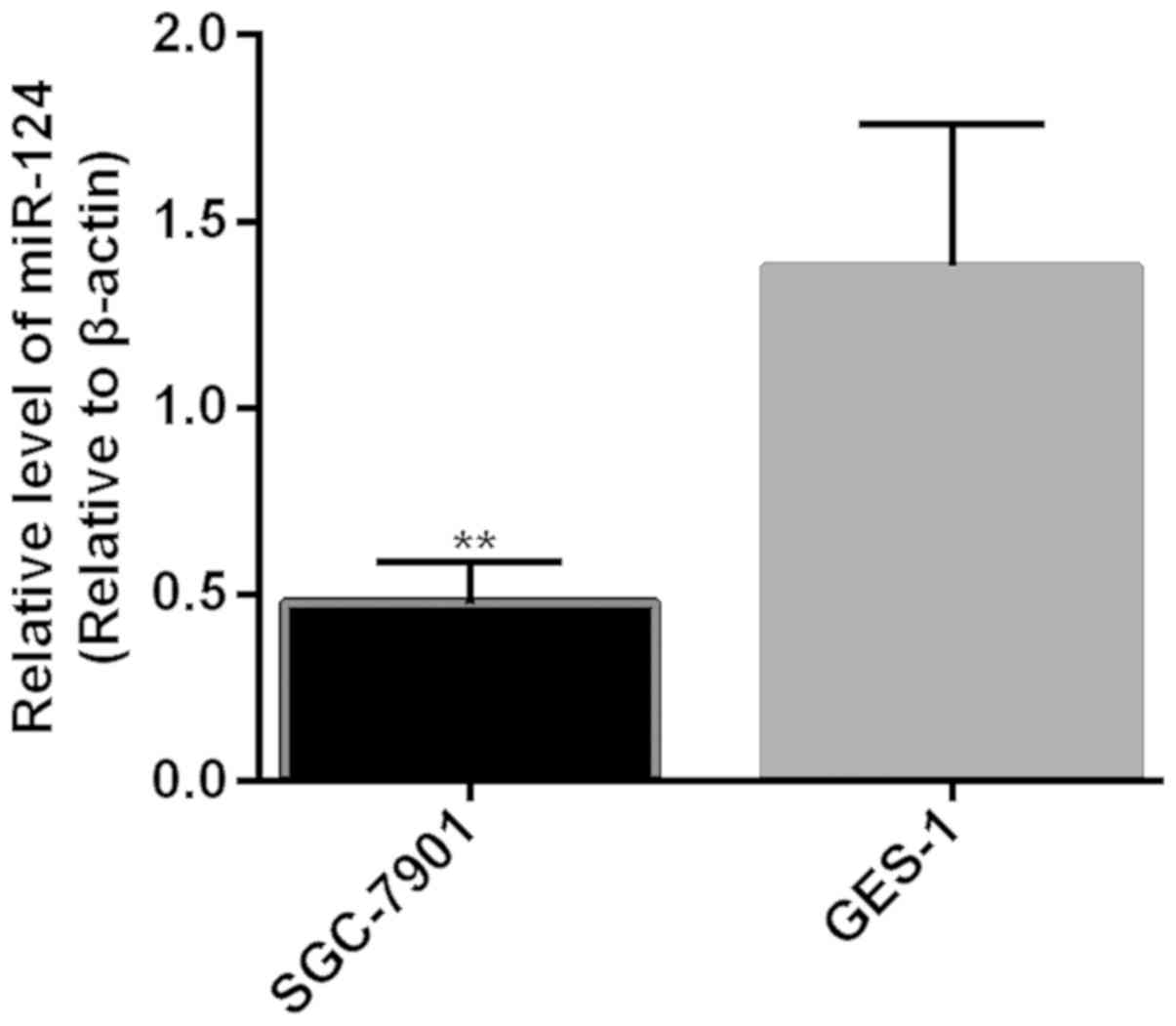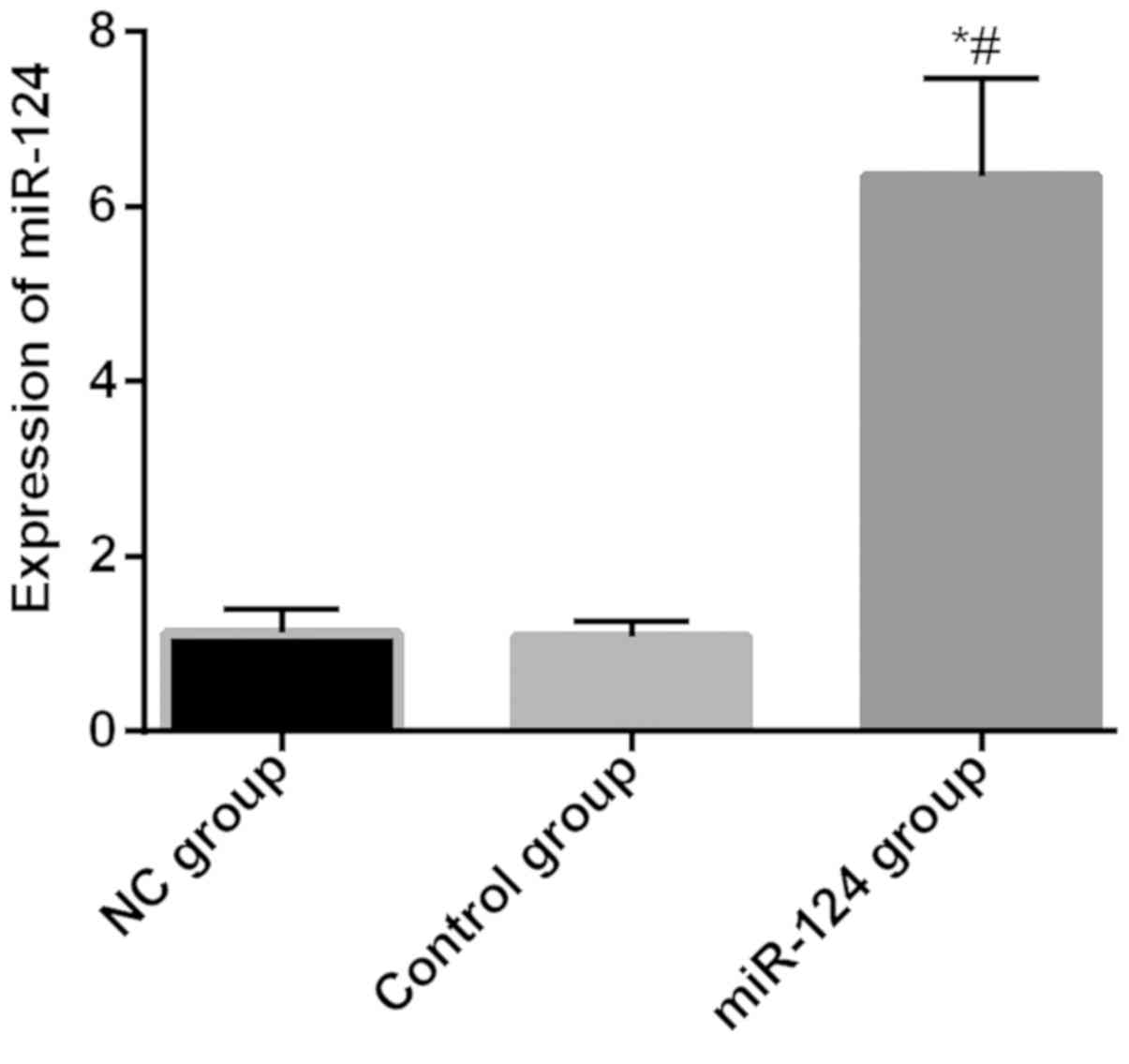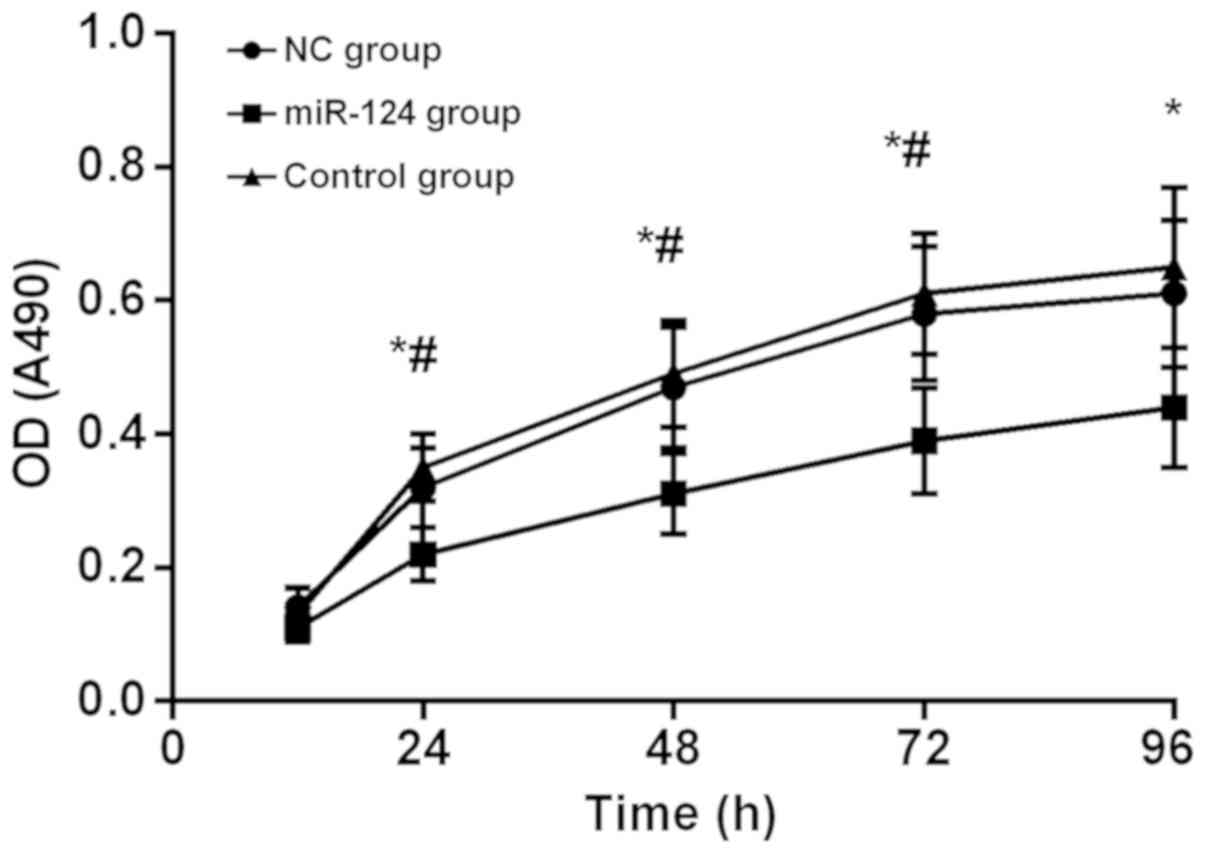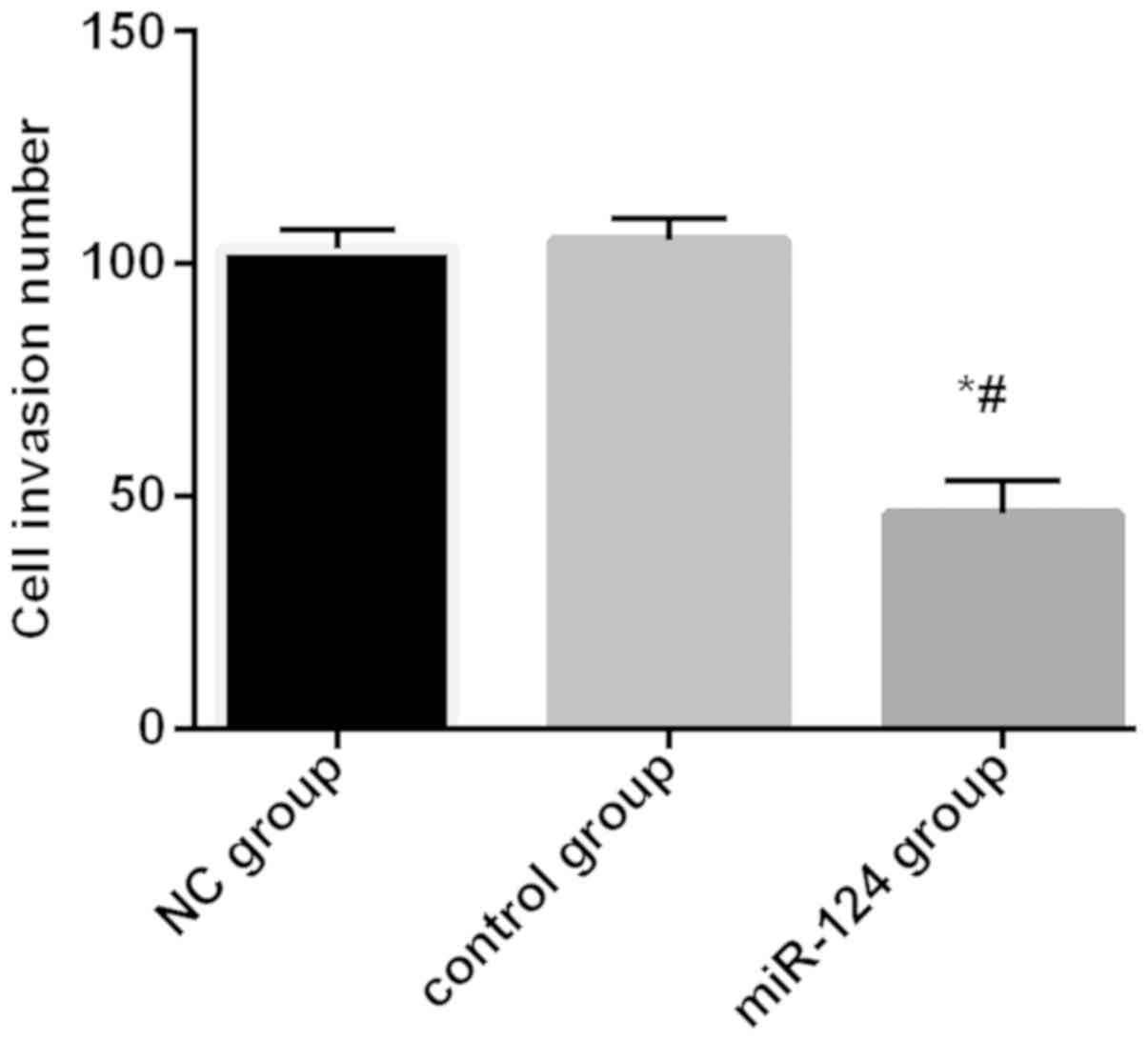Expression of miR-124 in gastric adenocarcinoma and the effect on proliferation and invasion of gastric adenocarcinoma SCG-7901 cells
- Authors:
- Published online on: January 28, 2019 https://doi.org/10.3892/ol.2019.9981
- Pages: 3406-3410
-
Copyright: © Mu et al. This is an open access article distributed under the terms of Creative Commons Attribution License.
Abstract
Introduction
Gastric cancer is one of the most common malignant tumors in the digestive system. In 2015, the American Cancer Society reported 24,590 new cases of gastric cancer in the United States, of which 63.20% were male (1). Of the 1 million new cases of gastric cancer in the world each year, Asians account for 74% (2). Incidence of gastric cancer has racial and regional characteristics (3). Gastric adenocarcinoma as the most common type of gastric cancer originates from the gastric glandular epithelial cells accounting for ~95% of gastric cancer (4). Pathogenesis of gastric cancer is not yet clear, and may be closely related to dietary habits and Helicobacter pylori (5). Oncogenes and suppressor genes, changes in epigenetics and changes in chromosome stability, are likely to alter cell proliferation, apoptosis, and invasion, and thus participate in the development of gastric cancer (6).
Numerous findings have shown that a variety of lncRNAs and miRNAs are involved in the occurrence of gastric cancer (7). miRNAs (~22 bp) are endogenous RNAs that do not encode protein, but play a regulatory role at the level of transcription and translation (8). miRNAs can bind to the 3′-untranslated region sequence of the target mRNA through base pairing, thereby degrading target mRNA or preventing translation of target mRNA, and play an important role in tumor cell proliferation, differentiation, and malignant transformation (9). It has been shown that miR-124 is downregulated in many cancer tissues such as liver cancer and can inhibit tumor growth (5,10). Liu et al (11) found that miR-124 may be a predictor of LNM and tumor stage in gastric cancer. In order to understand the role of miR-124 in gastric cancer, the present study investigated the expression of miR-124 in gastric cancer SGC-7901 cells and its effect on biological function. Our study provides a new potential molecular target for the treatment of gastric cancer.
Materials and methods
Cells and reagents
Gastric adenocarcinoma SGC-7901 cell line, human normal gastric mucosal epithelial GES-1 cells (Shanghai Guandao Bio-engineering Co., Ltd., Shanghai, China); miR-124 agomir and negative control sequence (Shanghai GenePharma Co., Ltd., Shanghai, China); fetal bovine serum and RPMI-1640 medium (Shanghai Hengyuan Biotechnology Co., Ltd., Shanghai, China); EasyPure miRNA kit, TransScript Green miRNA Two-Step qRT-PCR SuperMix kit (Beijing TransGen Biotech Co., Ltd., Beijing, China); Lipofectamine® 3000 transfection reagent and TRIzol reagent (Thermo Fisher Scientific, Inc., Waltham, MA, USA); qPCR primers (Sangon Biotech Co., Ltd., Shanghai, China); MTT (Yeasen Biotechnology, Co., Ltd., Shanghai, China); Transwell cell (Beijing Yiming Fuxing Biotechnology, Beijing, China).
The study was approved by the Ethics Committee of The First Hospital of Jilin University (Changchun, China). Signed informed consents were obtained from the patients or the guardians.
RT-qPCR detection of miR-124 expression in cancer and adjacent tissues. Fifty cases of identified gastric adenocarcinoma and paracancerous tissues were obtained in The First Hospital of Jilin University. RT-qPCR was used to detect the expression of miR-124 in cancer and adjacent tissues. TRIzol reagent was used to extract total RNA from cancer and paracancerous tissues. After purification using an EasyPure miRNA kit, the concentration and purity of RNA were detected by UV spectrophotometer. RNA samples with a A260/A280 ratio of 1.8–2.0 were subjected to reverse transcription in accordance with the reverse transcription kit instructions: 37°C for 1 h and 85°C 5 sec. qPCR reaction system was prepared strictly in accordance with the qPCR kit instructions. Reaction conditions of PCR reaction: 94°C for 30 sec, followed by 40 cycles of 94°C for 5 sec and 60°C for 30 sec. GAPDH was used as the endogenous control and the primer sequences are listed in Table I. The 2−ΔCq method was used to process qRT-PCR results (12).
Gastric adenocarcinoma tissue inclusion criteria (13): i) pathological examination confirmed gastric adenocarcinoma; ii) intended for surgical treatment; iii) patients with normal functions of important organs such as heart and lung and patients were able to withstand surgical resections; iv) signed informed consent. Exclusion criteria were: i) patients with postoperative recurrence of gastric cancer and recurrent gastric cancer; ii) history of abdominal surgery, abdominal abscess, and peritoneal inflammation; iii) patients with important organ dysfunction; iv) recent use of hormone drugs, blood products and immunosuppressive agents; v) received preoperative radiation therapy, chemotherapy and other antitumor therapy.
Cell transfection
Cells were divided into miR-124 agomir group, NC group and blank group. Cells were incubated with RPMI-1640 medium containing 10% FBS at 37°C in a 5% CO2 incubator. Transfection was performed when the cell confluence reached 80% and transfection was performed strictly in accordance with the instructions of Lipofectamine® 3000. Cells in miR-124 group were transfected with miR-124 agomir, cells in NC group were transfected with agomir negative control sequence and cells in control group were not transfected. Cells were incubated for 5 min at room temperature and plasmid DNA and liposome complexes were mixed with the cells. Cultured cells were incubated at 37°C with 5% CO2 for 2 days and transfection was checked. Then, the cell was collected for subsequent experimentation.
RT-qPCR detection of miR-124 expression in different groups of cells
RT-qPCR was used to detect the expression of miR-124 in each group. Specific methods used were the same as in ‘Cells and reagents’.
MTT assay to detect cell proliferation
When the cell confluency reached 80%, cell suspensions were prepared with a cell density of 2×104 cells/ml. Then, 200 µl cell suspension was added into each well of a 96-well plate. Cell viability was measured by MTT assay. A total of 20 µl of 5 mg/ml MTT solution was added into each well at 12, 24, 48, 72, and 96 h after the initiation of cell culture for color development. After incubation for another 4 h, 150 µl Formanzan Lysing Solution was added into each well, followed by shaking at room temperature for 10 min. When crystals were completely dissolved, absorbance (OD) at the wavelength of 490 nm was measured using a microplate reader. The measurement was repeated 3 times.
Transwell invasion assay to detect cell invasion ability
Serum-free DMEM medium was used to starve cultured cells for 12 h to remove the effects from serum. When cell confluence reached 80%, cells were resuspended with the invasion buffer. Cells were counted and cell density was adjusted to 5×104/ml. A total of 200 µl of cell suspension was evenly spread over 6-well Transwell upper chamber (cat. no. 354480; BD Biosciences, Franklin Lakes, NJ, USA) polycarbonate membrane and 600 µl of DMEM medium containing 20% fetal bovine serum was added into the lower chamber. The cells were cultured at 37°C with 5% CO2 for 24 h. A cotton swab was used to gently wipe off the uninvaded cells on polycarbonate membrane. After washing with PBS 3 times, the membrane was fixed with 4% paraformaldehyde for 10 min, followed by crystal violet staining for 10 min. After washing with PBS 3 times, 5 visual fields (×400) were selected under a microscope (Olympus Corporation, Tokyo, Japan) to count cells and calculate the average value.
Statistical analysis
SPSS20.0 [AsiaAnalytics (formerly SPSS China), Shanghai, China] statistical software package was used to test and analyze the data. Measured data were expressed as mean ± standard deviation. ANOVA followed by LSD test was used for comparisons among three groups. Comparisons of data at different time-points in the same group of MTT assay were performed by repeated measures analysis of variance. Significance level was α=0.05.
Results
Expression of miR-124 in gastric adenocarcinoma tissues and adjacent tissues
Expression level of miR-124 in gastric adenocarcinoma tissue (0.35±0.02) was significantly lower than that in paracancerous tissue (1.34±0.06) (P<0.01). Expression level of miR-124 in cancer tissue was lower than that in corresponding paracarcinoma tissues in 45 cases, and the downregulation rate was 90% (Fig. 1).
Expression of miR-124 in GES-1 and SGC-7901 before transfection
Expression level of miR-124 in cells of the SGC-7901 cell line (0.48±0.11) was significantly lower than that in cells of the GES-1 cell line (1.38±0.38) (P<0.01) (Fig. 2).
Expression of miR-124 in cells of miR-124, NC and control groups after transfection
Relative expression levels of miR-124 in NC group, control group and miR-12 group were 1.12±0.28, 1.09±0.17, 6.35±1.11, respectively. Relative expression level of miR-124 in miR-12 group was significantly higher than that in the NC and control groups (P<0.05), and there was no difference between the NC and control groups (P>0.05) (Fig. 3).
Cell proliferation after miR-124 transfection
At 12 h after transfection, there was no significant difference in OD at 490 nm among the 3 groups (P>0.05). OD (490) of miR-124 group, NC group and control group at 24 h were 0.22±0.04, 0.32±0.06 and 0.35±0.05, respectively, OD (490) and miR-124 group was significantly lower than that in NC group and control group (P<0.01). The difference between NC group and control group was not statistically significant (P>0.05). OD (490) in all three groups showed a gradual upward trend, but at 24 h, OD (490) in miR-124 group was significantly lower than that in NC group and control group (P<0.01), but there was no difference between NC group and control group (P>0.05). OD values of all 3 groups at 24, 48, and 72 h were all higher than those at the previous time-point (P<0.01), and there was no significant difference between 96 h and 72 h (P>0.05). OD values at different time-points in each group are listed in Table II, and the MTT proliferation curve is shown in Fig. 4.
Invasion ability of cells after miR-124 transfection
The number of invading cells in miR-124 group, NC group, and control group was 46.17±7.13, 103.13±4.14, and 105.11±4.62, respectively. The number of invading cells in miR-124 group was significantly lower than that of the NC group and control group (P<0.01). There was no significant difference in the number of invading cells between NC group and control group (Fig. 5).
Discussion
In China, with the gradual increase of economic level, incidence and mortality of gastric cancer have also increased year by year (14), and the onset age of disease is becoming younger and younger (15). Symptoms of early gastric cancer are not obvious. Most patients were in advanced or late metastasis stage at the time of diagnosis. More than half of the patients have recurrence after surgery. Chemotherapy is also ineffective in some cases due to multiple drug resistance (16). miRNAs play an important role in the development of tumors and have been the focus of research in recent years (17). Studies have shown that miR-124 can inhibit the progression of cancer such as liver cancer and cervical cancer, promote the differentiation of CD133 tumors, and induce tumor cell apoptosis (18). Studies have shown that miR-124 is downregulated in gastric cancer, but the mechanism of action of miR-124 in gastric cancer remains unclear. Therefore, the expression of miR-124 in gastric cancer SGC-7901 cells and its effect on biological function were explored in this study and the role of miR-124 in gastric cancer was evaluated.
Expression level of miR-124 in gastric adenocarcinoma tissues was significantly lower than that in paracancerous tissues and expression level of miR-124 in SGC-7901 cells was significantly lower than that in GES-1 cells, indicating that miR-124 was downregulated in gastric cancer tissues. Hu et al (19) also found that miR-124 expression level was significantly reduced in gastric adenocarcinoma tissue samples and cell lines. After transfection, although proliferation curves of all three groups showed an upward trend, cell proliferation rate in miR-124 group was significantly lower than that in NC group and control group, indicating inhibited cell proliferation after miR-124 transfection. Pan et al (20) found that lentiviral vectors that stably express miR124 can inhibit the growth, migration, and invasion of gastric cancer cells. Li et al (21) found that miR-124 can inhibit cell invasion and epithelial mesenchymal transformation by inhibiting Snail2 expression.
In this study, the downregulated expression of miR-124 in gastric adenocarcinoma was verified at both tissue and cell levels. We conclude that miR-124 is downregulated in gastric adenocarcinoma tissue and miR-124 can inhibit the proliferation and invasion of gastric adenocarcinoma cells and inhibit the development of gastric adenocarcinoma. However, only one cell line was used and conclusions may be biased. We will include more cell lines in our future studies. Although MTT and Transwell invasion experiments have shown that miR-124 can inhibit the proliferation and invasion of gastric adenocarcinoma cells, the downstream target genes and specific signaling pathways remain to be further studied.
Through literature investigations, we found that downstream target genes of miR-124 are SPHK1 and ROCK. These target genes will be verified in our subsequent studies and relevant pathways will also be identified. Xia et al (22) found that miR-124 can downregulate SPHK1. The expression of miR-124 in gastric cancer tissues is reduced and the silencing effect on SPHK1 is relieved. SPHK1 expression is increased in gastric cancer and closely related to the shortened survival time of patients. Hu et al (19) found that miR-124 overexpression inhibits ROCK1 and miR-124 functions as a tumor suppressor by targeting ROCK1. Jiang et al (23) found that miR-124 negatively regulates Notch1 signaling by targeting JAG1 to inhibit GC cell growth, migration, invasion and induce cell cycle arrest. In conclusion, miR-124 can inhibit the proliferation and invasion of gastric adenocarcinoma cells. Downregulation of miR-124 expression in gastric adenocarcinoma may be closely related to the development of gastric adenocarcinoma.
Acknowledgements
Not applicable.
Funding
No funding was received.
Availability of data and materials
The datasets used and/or analyzed during the present study are available from the corresponding author on reasonable request.
Authors' contributions
JM and HW drafted the manuscript. JM, HW and XW were mainly devoted to collecting and interpreting the data. XW and PS were responsible for PCR and MTT assays. All authors read and approved the final study.
Ethics approval and consent to participate
The study was approved by the Ethics Committee of The First Hospital of Jilin University (Changchun, China). Signed informed consents were obtained from the patients or the guardians.
Patient consent for publication
Not applicable.
Competing interests
The authors declare that they have no competing interests.
References
|
Li H, Xie S, Liu M, Chen Z, Liu X, Wang L, Li D and Zhou Y: The clinical significance of downregulation of mir-124-3p, mir-146a-5p, mir-155-5p and mir-335-5p in gastric cancer tumorigenesis. Int J Oncol. 45:197–208. 2014. View Article : Google Scholar : PubMed/NCBI | |
|
Maiarù M, Morgan OB, Tochiki KK, Hobbiger EJ, Rajani K, Overington DW and Géranton SM: Complex regulation of the regulator of synaptic plasticity histone deacetylase 2 in the rodent dorsal horn after peripheral injury. J Neurochem. 138:222–232. 2016. View Article : Google Scholar : PubMed/NCBI | |
|
Wang SE, Ko SY, Jo S, Choi M, Lee SH, Jo HR, Seo JY, Lee SH, Kim YS, Jung SJ, et al: TRPV1 regulates stress responses through HDAC2. Cell Rep. 19:401–412. 2017. View Article : Google Scholar : PubMed/NCBI | |
|
Wang X, Li Y, Dai Y, Liu Q, Ning S, Liu J, Shen Z, Zhu D, Jiang F, Zhang J, et al: Sulforaphane improves chemotherapy efficacy by targeting cancer stem cell-like properties via the miR-124/IL-6R/STAT3 axis. Sci Rep. 6:367962016. View Article : Google Scholar : PubMed/NCBI | |
|
Zhang Y, Li H, Han J and Zhang Y: Down-regulation of microRNA-124 is correlated with tumor metastasis and poor prognosis in patients with lung cancer. Int J Clin Exp Pathol. 8:1967–1972. 2015.PubMed/NCBI | |
|
Wang M, Gu H, Wang S, Qian H, Zhu W, Zhang L, Zhao C, Tao Y and Xu W: Circulating miR-17-5p and miR-20a: Molecular markers for gastric cancer. Mol Med Rep. 5:1514–1520. 2012.PubMed/NCBI | |
|
Pei L, Xia JZ, Huang HY, Zhang RR, Yao LB, Zheng L and Hong B: Role of miR-124a methylation in patients with gastric cancer. Zhonghua Wei Chang Wai Ke Za Zhi. 14:136–139. 2011.(In Chinese). PubMed/NCBI | |
|
Xie L, Zhang Z, Tan Z, He R, Zeng X, Xie Y, Li S, Tang G, Tang H and He X: MicroRNA-124 inhibits proliferation and induces apoptosis by directly repressing EZH2 in gastric cancer. Mol Cell Biochem. 392:153–159. 2014. View Article : Google Scholar : PubMed/NCBI | |
|
Xiao HJ, Ji Q, Yang L, Li RT, Zhang C and Hou JM: In vivo and in vitro effects of microRNA-124 on human gastric cancer by targeting JAG1 through the Notch signaling pathway. J Cell Biochem. 119:2520–2534. 2018. View Article : Google Scholar : PubMed/NCBI | |
|
Zhang TH, Liang LZ, Liu XL, Wu JN, Su K, Chen JY, Zheng QY, Huang HZ and Liao GQ: Long non-coding RNA MALAT1 interacts with miR-124 and modulates tongue cancer growth by targeting JAG1. Oncol Rep. 37:2087–2094. 2017. View Article : Google Scholar : PubMed/NCBI | |
|
Liu L, Ye JX, Qin YZ, Chen QH and Ge LY: Evaluation of miR-29c, miR-124, miR-135a and miR-148a in predicting lymph node metastasis and tumor stage of gastric cancer. Int J Clin Exp Med. 8:22227–22236. 2015.PubMed/NCBI | |
|
Livak KJ and Schmittgen TD: Analysis of relative gene expression data using real-time quantitative PCR and the 2(-Delta Delta C(T)) method. Methods. 25:402–408. 2001. View Article : Google Scholar : PubMed/NCBI | |
|
Costa WL Jr, Coimbra FJ, Fogaroli RC, Ribeiro HS, Diniz AL, Begnami MD, Mello CA, Fanelli MF, Silva MJ, Fregnani JH, et al: Adjuvant chemoradiotherapy after d2-lymphadenectomy for gastric cancer: The role of n-ratio in patient selection. results of a single cancer center. Radiat Oncol. 7:1692012. View Article : Google Scholar : PubMed/NCBI | |
|
Chen W, Zheng R, Baade PD, Zhang S, Zeng H, Bray F, Jemal A, Yu XQ and He J: Cancer statistics in China, 2015. CA Cancer J Clin. 66:115–132. 2016. View Article : Google Scholar : PubMed/NCBI | |
|
Zhou J, Zhou J, Wang W, Li W, Wu L, Li G, Shi J and Zhou S: The polymorphism in miR-25 attenuated the oncogenic function in gastric cancer. Tumour Biol. 37:5515–5520. 2016. View Article : Google Scholar : PubMed/NCBI | |
|
Maeda M, Yamashita S, Shimazu T, Iida N, Takeshima H, Nakajima T, Oda I, Nanjo S, Kusano C, Mori A, et al: Novel epigenetic markers for gastric cancer risk stratification in individuals after Helicobacter pylori eradication. Gastric Cancer 1113. 1–11. 2018. | |
|
Yuan Q, Sun T, Ye F, Kong W and Jin H: MicroRNA-124-3p affects proliferation, migration and apoptosis of bladder cancer cells through targeting AURKA. Cancer Biomark. 19:93–101. 2017. View Article : Google Scholar : PubMed/NCBI | |
|
Huang T, Zhou Y, Zhang J, Wong CC, Li W, Kwan JSH, Yang R, Chan AKY, Dong Y, Wu F, et al: SRGAP1, a crucial target of miR-340 and miR-124, functions as a potential oncogene in gastric tumorigenesis. Oncogene. 37:1159–1174. 2018. View Article : Google Scholar : PubMed/NCBI | |
|
Hu CB, Li QL, Hu JF, Zhang Q, Xie JP and Deng L: miR-124 inhibits growth and invasion of gastric cancer by targeting ROCK1. Asian Pac J Cancer Prev. 15:6543–6546. 2014. View Article : Google Scholar : PubMed/NCBI | |
|
Pan Y, Wu A, Xu F, Chen C, Jiang L and Jin R: Lentivirus-mediated overexpression of miR-124 suppresses growth and invasion by targeting JAG1 and EZH2 in gastric cancer. Oncol Lett. 15:7450–7458. 2018.PubMed/NCBI | |
|
Li SL, Gao HL, Lv XK, Hei YR, Li PZ, Zhang JX and Lu N: MicroRNA-124 inhibits cell invasion and epithelial-mesenchymal transition by directly repressing Snail2 in gastric cancer. Eur Rev Med Pharmacol Sci. 21:3389–3396. 2017.PubMed/NCBI | |
|
Xia J, Wu Z, Yu C, He W, Zheng H, He Y, Jian W, Chen L, Zhang L and Li W: miR-124 inhibits cell proliferation in gastric cancer through down-regulation of SPHK1. J Pathol. 227:470–480. 2012. View Article : Google Scholar : PubMed/NCBI | |
|
Jiang L, Lin T, Xu C, Hu S, Pan Y and Jin R: miR-124 interacts with the Notch1 signalling pathway and has therapeutic potential against gastric cancer. J Cell Mol Med. 20:313–322. 2016. View Article : Google Scholar : PubMed/NCBI |



